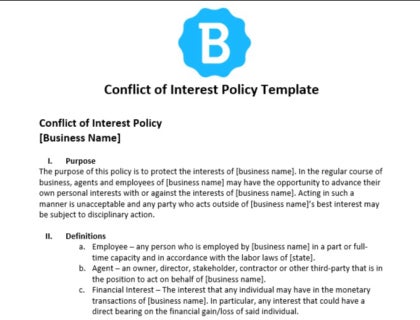
Conflict of Interest Policy Template.
Use our conflict of interest policy template to create a customized policy for your organization.
Download NowConflict of Interest Policy Sample:
Conflict of Interest Policy
[Business Name]
I. Purpose.
The purpose of this policy is to protect the interests of [business name]. In the regular course of business, agents and employees of [business name] may have the opportunity to advance their own personal interests with or against the interests of [business name].
Acting in such a manner is unacceptable and any party who acts outside of [business name]’s best interest may be subject to disciplinary action.
II. Definitions.
a. Employee – any person who is employed by [business name] in a part or full-time capacity and in accordance with the labor laws of [state].
b. Agent – an owner, director, stakeholder, contractor, or other third-party that is in the position to act on behalf of [business name].
c. Financial Interest – The interest that any individual may have in the monetary transactions of [business name]. In particular, any interest that could have a direct bearing on the financial gain/loss of the said individual.
III. Procedure.
a. Duty to disclose
Every employee/agent of [business name] is obligated to disclose any known or potential conflicts of interest as soon as they arise. Failure to do so could result in termination of employment.
b. Investigating potential conflicts
When a possible conflict of interest arises, the board of directors will collect all of the pertinent information and may question any concerned parties. If the board determines that a conflict exists, steps will be taken to address the conflict. If no conflict exists, the inquiry may be documented but no further action will be taken.
c. Addressing conflicts of interest
When an actual conflict of interest is found, any transactions that may have been affected will be reviewed retroactively. Affected parties both within and outside of the business, including shareholders, directors, employees, and contractors will be notified.
An investigation will also be conducted by the board of directors to determine the extent of the conflict and the intentions of the parties involved.
If the conflict in question involves a member or members of the board of directors, such a member will be excused from the deliberations.
d. Disciplinary action
As all conflicts of interest will be reviewed on a case-by-case basis, a review may result in disciplinary action. The board of directors has full discretion to deem what disciplinary action is both fitting and necessary, including suspension and/or termination of employment.
IV. Acknowledgment.
The employee/agent named below understands the procedure for conflicts of interest with [business name], including their duty to disclose any known or potential conflicts.
Furthermore, the employee/agent agrees to abide by the procedures outlined in this policy for the duration of their professional relationship with [business name].
Employee Name: Date:
Signature:
How to Write a Conflict of Interest Policy:
Follow our detailed step-by-step guide to writing a conflict of interest policy.
Outline your policy.
State the purpose.
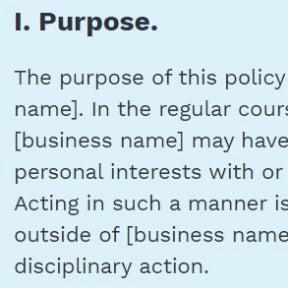
Your conflict of interest policy should begin with a brief statement of the purpose of the document. This tells employees why the policy exists and how it will help them to make the right decisions as they go about their duties as an agent/employee of your business.
Explain relevant interests.
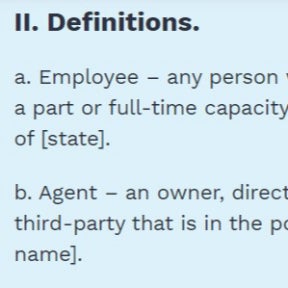
A conflict of interest can show up in many different forms, but usually, it holds an aspect of financial gain for the employee that may or may not align with the overall mission of the business. For example, an employee who holds stock in a competing company may stand to gain by disclosing inside information to their competitor.
Potential conflicts like these should be explained in the policy.
Define the policy procedure.
Outline the procedure for handling conflict.
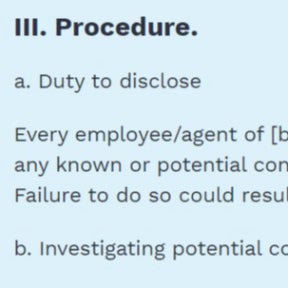
The "procedure" portion of a conflict of interest policy is generally the longest and most detailed part. It includes details like what an employee should do if they believe a conflict exists, how a conflict will be investigated or resolved, who will be involved in resolving conflicts of interest, and so on.
Note disciplinary action.
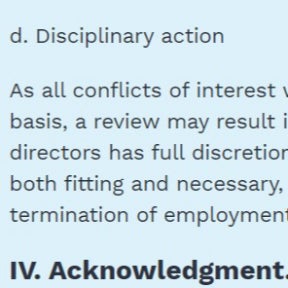
Immediately after the "procedure" section, most policies describe any disciplinary actions that will be taken if an employee is found to have knowingly acted upon a conflict of interest. Disciplinary actions may include temporary suspension or even termination of employment.
Close your policy.
Add a consent form
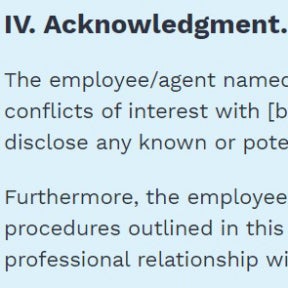
The consent form may even include a brief questionnaire to identify the employee's exact position within the company, with questions like, "Are you an officer of the organization that conducts business with [XYZ]?"
Include a signature.
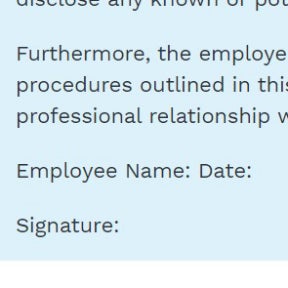
Every conflict of interest policy should include an area for employees to sign and date the document. If the policy is long, this may be included on a separate page. If the policy is brief, it can be included at the bottom of the page.
What to Include in a Conflict of Interest Policy:
- An outline of possible conflicts that could arise in the course of business.
- Details about disciplinary actions that will be taken if an employee is found to have violated the policy.
- The procedure for handling potential or actual conflicts.
- A statement about an employee's duty to disclose any conflicts of interest that they are aware of.
- A signature from the employee signifying their acknowledgment of the policy and their intention to adhere to it.


